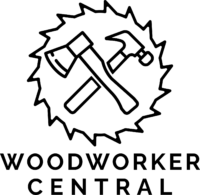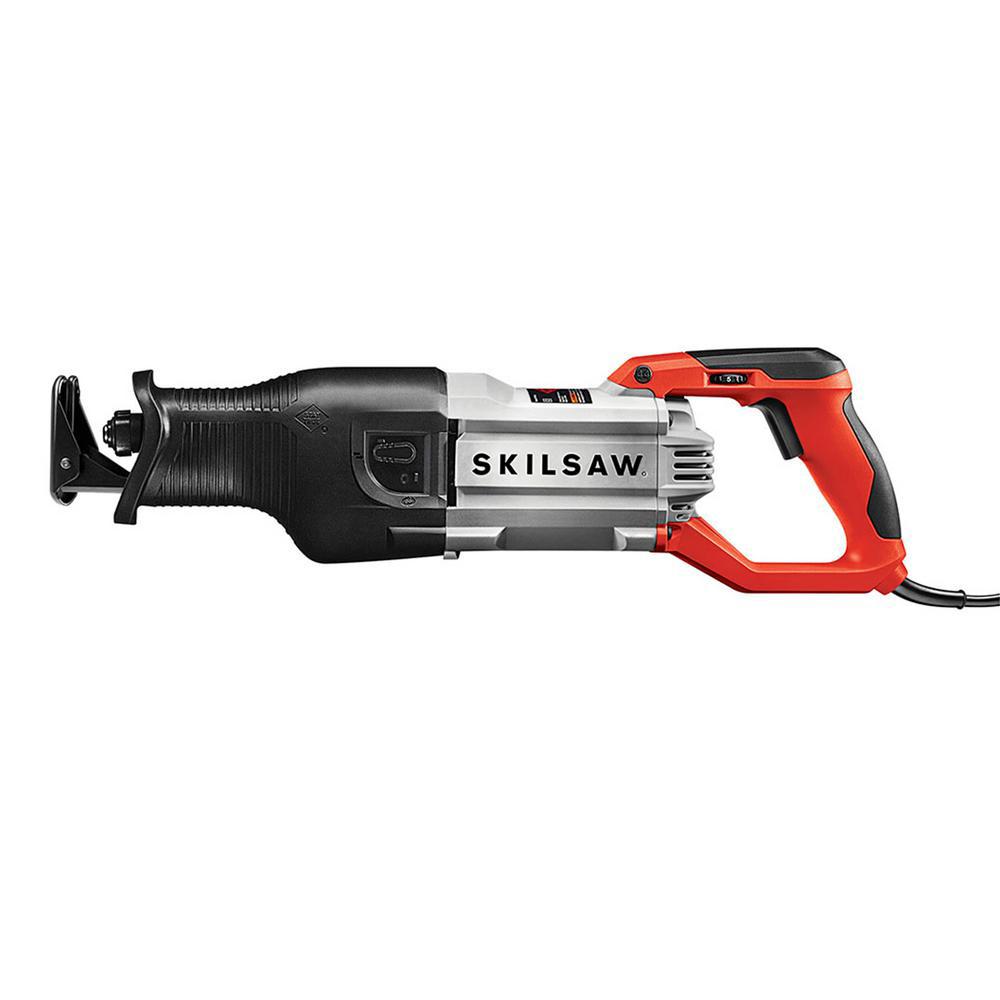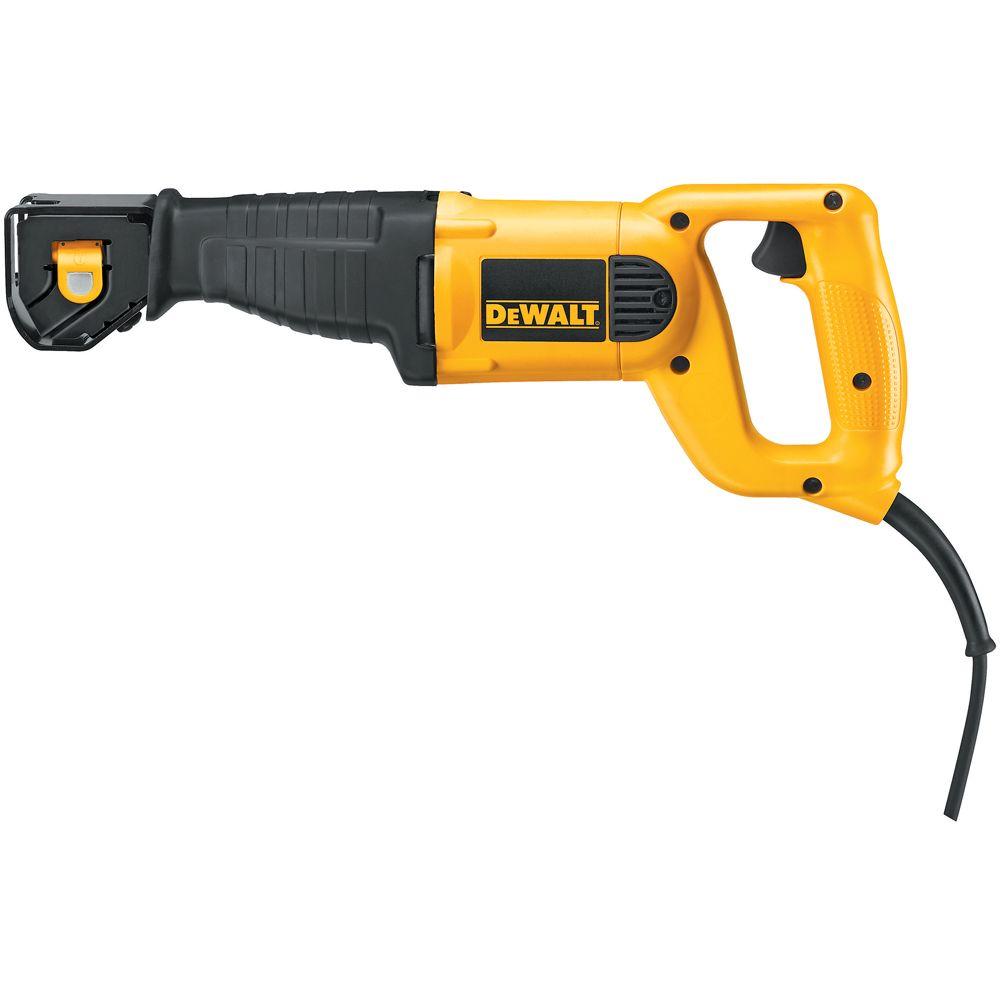
Think of reciprocating saws as the big brothers to jig saws. They cut using reciprocating (forward-and-back) motions. Also commonly called ‘sawzalls’, reciprocating saws are mainly used for deconstruction purposes.
If you’ve ever watched a home renovation reality show, you’ve seen a reciprocating saw. They’re usually featured towards the beginning of the episode along with sledge hammers when people are smashing cabinets and cutting through studs.
Demolition is a popular use for reciprocating saws. Reciprocating saws make quick work of cutting through all sorts of materials thanks to their powerful motors and long blade strokes. With the right blade, these saws can quickly slice through wood, metal, PVC, or drywall.
If you’re renovating a room (or rooms) or need to quickly break down material, a reciprocating saw definitely has a spot in your space. When you’re doing demo work or just need a quick cut on a heavy piece of stock, a reciprocating saw will be your best bet.
They’re also very portable. Reciprocating saws come in both corded and cordless flavors so there are plenty of options to choose from.
The Quick Answer
The SKILSAW SPT44A is our top choice. It packs a bunch of power and an innovative vibration-reduction technology.
The DEWALT DWE304 is also a great choice with its versatile blade clamp that allows you to orient the blade in four different directions.
The PORTER-CABLE PCE360 is the cheapest of the three and includes the fewest features. If you’re looking for a budget-friendly sawzall, give this one a consideration.
SKILSAW SPT44A
The SPT44A packs a bunch of power for this saw class with 13 amps. This is partially the reason for the extra weight. The SKILSAW is particularly heavy at 9 lbs. Not necessarily a pro or con depending on how you feel about tool weight, but it’s something to consider.
Blades are changed with a twist-lock mechanism. The footplate pivots to help maneuver around curved or profiled workpieces.
The ace up the sleeve for the SPT44A is its patented Buzzkill feature. An internal counterbalance system drastically lowers vibrations in the body of the saw. This is a good thing for two reasons. First, the saw is just more comfortable to use since it doesn’t rattle your bones as much. Second, energy is typically lost in saw body vibrations. By lowering this energy loss, more energy is transferred to the blade and to the cut. This system is the other source for the added weight.
We like this saw a lot. Its features and power make it a strong contender for anyone looking for a reciprocating saw for their shop.
DEWALT DWE304
DEWALT’s DWE304 brings a good amount of power at 10 amps, which can tackle most jobs. Wood, metal, and plastic shouldn’t be an issue with the right blade affixed to this reciprocating saw.
The blade change mechanism uses a lever lock, which we like a lot. The normal twist lock found on other saws works well, but we like the definitive and sure locking motion that the lever provides. The footplate doesn’t pivot, but we didn’t find this to be that much of an issue. It’s sturdy and provides plenty of support when charging through a variety of materials.
The defining feature of the DEWALT is its blade clamp. Most other saws clamp the blade with the teeth facing down. The DWE304 can do that too, but it can also orient the blade up, left, and right as well. This is an immensely useful feature for flush cuts or up cuts. Other saws require awkward tool positioning to make cuts. In our experience, awkward cuts are usually dangerous cuts. DEWALT aims to remedy this by giving you the option to flip the blade to the most natural position for the cut you’re about to make. We really like this feature.
PORTER-CABLE PCE360
The PCE360 is your standard entry-level reciprocating saw. It doesn’t include a bunch of innovative features, but it is priced lower than most so it fits the bill for an economic demolition machine.
At 7.5 amps, it’s underpowered compared to others. Light demo work shouldn’t be an issue, although it may take more time to power through tougher materials. The PCE360 weighs less than most, so arm fatigue is kept to a minimum.
The twist-lock mechanism allows for quick blade changes and the pivoting foot helps navigate over any contour you encounter. The shoe also extends to adjust for any cutting depth you need.
Give the PCE360 from PORTER-CABLE a look if you want a low-priced entry-level sawzall.
Which Reciprocating Saw Is the Best For Your Shop?
SKILSAW, PORTER-CABLE, and DEWALT introduce their corded reciprocating saws into the medium-duty class. These saws offer reasonable power at affordable prices to accomplish nearly everything a weekend warrior can throw at them. The SKILSAW SPT44A, PORTER-CABLE PCE360, and DEWALT DWE304 stack against each other in our comparison below. We’ll do our best to determine which is the best reciprocating saw (or best sawzall) for our shop and yours.
Full reviews for each saw can be found here:
Scoring will be based on each saw’s performance in four categories. Also, units can score equally if deserved in a particular category (e.g. a first, second, third, etc isn’t forced). For this comparison, the max score possible is set at 100 and the minimum score is 20.
Which Reciprocating Saw Offers the Most Power?
Exemplary = 25 points
Satisfactory = 15 points
Below Average = 5 points
Power offerings differ quite a bit among the three models. PORTER-CABLE offers an underwhelming 7.5 amps, DEWALT includes the industry average of 10 amps, and SKILSAW packs an above-average 13 amps.
SKILSAW earns 25 points, DEWALT earns 15 points, and PORTER-CABLE earns 5 points.
Which Saw Is the Most Comfortable to Use?
Exemplary = 25 points
Satisfactory = 15 points
Below Average = 5 points
Ergonomics are similar from a form factor perspective, but additional features make or break this comparison. The PORTER-CABLE presents the standard package with nothing above and beyond the competitor average. The DEWALT’s four-position blade clamp allows for a variety of cutting positions. The blade can be oriented up, down, left, or right and the saw can perform any cutting job comfortably without unnaturally contorting yourself to accomplish awkward cuts. SKILSAW’s patented Buzzkill technology uses internal counterbalances to significantly reduce vibrations. This allows the user to confidently address the workpiece with minimal shaking. We’ve found that excess vibrations usually lead to inaccurate cuts.
PORTER-CABLE earns 15 points and SKILSAW and DEWALT earn 25 points each.
Which Reciprocating Saw Has the Best Price?
Exemplary = 25 points
Satisfactory = 15 points
Below Average = 5 points
Price and features seem to be tightly correlated with this group. Nevertheless, the PORTER-CABLE is a steal at around $50 depending on the day, with the DEWALT and SKILSAW priced nearly double. The PORTER-CABLE is priced very aggressively and is hard to beat for a solid, corded reciprocating saw.
PORTER-CABLE earns 25 points and SKILSAW and DEWALT earn 15 points each.
Which Saw Has the Best Features?
Exemplary = 25 points
Satisfactory = 15 points
Below Average = 5 points
As mentioned before, the DEWALT includes a very convenient four-position blade clamp. Awkward approach angles are a thing of the past and the saw easily accomplishes flush cuts when the blade is oriented in one of the two flat positions. We really like this feature on the DEWALT. The SKILSAW’s Buzzkill feature is a welcome respite to the bone-shaking experience that is the sawzall, especially when cutting harder materials like metal. PORTER-CABLE doesn’t really offer anything compelling beyond the standard suite of features, which is represented in its price.
PORTER-CABLE earns 15 points and SKILSAW and DEWALT earn 25 points each.
Final Results
The SKILSAW SPT44A leads the pack as the best reciprocating saw with its impressive power and vibration-reducing technology. DEWALT’s DWE304 comes in at a close second with its unique blade clamp that offers multiple blade orientations. The aggressively-priced PORTER-CABLE PCE360 offers a bunch in a low-priced package, but doesn’t quite offer the user experience as the other two saws.



